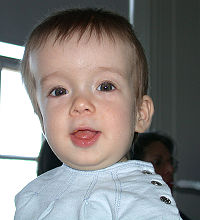
Photo from wikipedia
OBJECTIVE To study the audiological outcome and early screening of pre-school going children with craniosynostosis under follow-up at the University of Malaya Medical Center(UMMC), Kuala Lumpur, Malaysia over a 10… Click to show full abstract
OBJECTIVE To study the audiological outcome and early screening of pre-school going children with craniosynostosis under follow-up at the University of Malaya Medical Center(UMMC), Kuala Lumpur, Malaysia over a 10 year period. METHODS A retrospective descriptive cohort study on the audiological findings detected during the first hearing assessment done on a child with craniosynostosis using otoacoustic emissions, pure tone audiometry or auditory brainstem response examination. The main aim of this study was to evaluate the type and severity of hearing loss when compared between syndromic and non-sydromic craniosynostosis, and other associated contributory factors. RESULTS A total of 31 patients with 62 ears consisting of 14 male patients and 17 female patients were evaluated. Twenty two patients (71%) were syndromic and 9 (29%) were non-syndromic craniosynostosis. Amongst the syndromic craniosynostosis, 9 (41%) had Apert syndrome, 7 (32%) had Crouzon syndrome, 5 (23%) had Pfieffer syndrome and 1 (4%) had Shaethre Chotzen syndrome. Patients with syndromic craniosynostosis were more likely to present with all types and severity of hearing loss, including severe to profound sensorineural hearing loss while children with non-syndromic craniosynostosis were likely to present with normal hearing (p < 0.05). In addition, when the first hearing test was done at a later age, a hearing loss including sensorineural hearing loss is more likely to be present in a child with syndromic craniosynostosis (p < 0.05). CONCLUSION Our study suggested that children who are born with syndromic craniosynostosis were more likely to suffer from a hearing loss, including that of a severe to profound degree compared to children with non-syndromic craniosynostosis. In addition to that, hearing loss is more likely to be detected when the first hearing test is done at a later age, and this can be an irreversible sensorineural hearing loss. We would like to advocate the need for early audiological screening and follow up in children with syndromic craniosynostosis.
Journal Title: International journal of pediatric otorhinolaryngology
Year Published: 2018
Link to full text (if available)
Share on Social Media: Sign Up to like & get
recommendations!